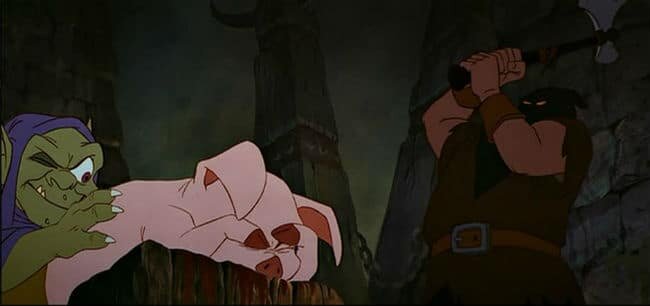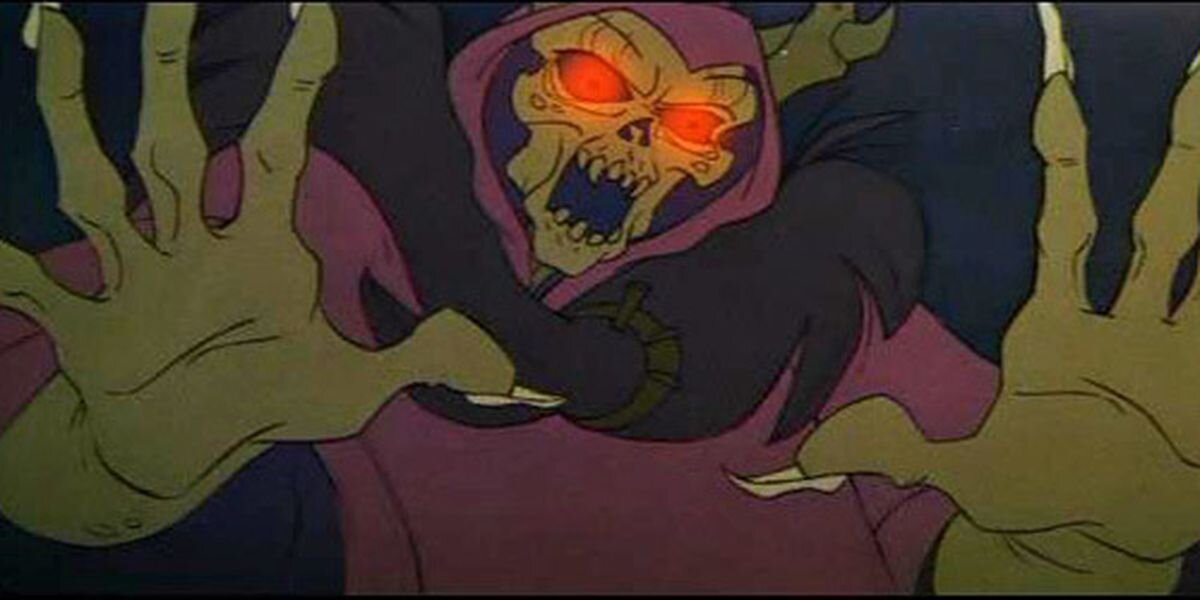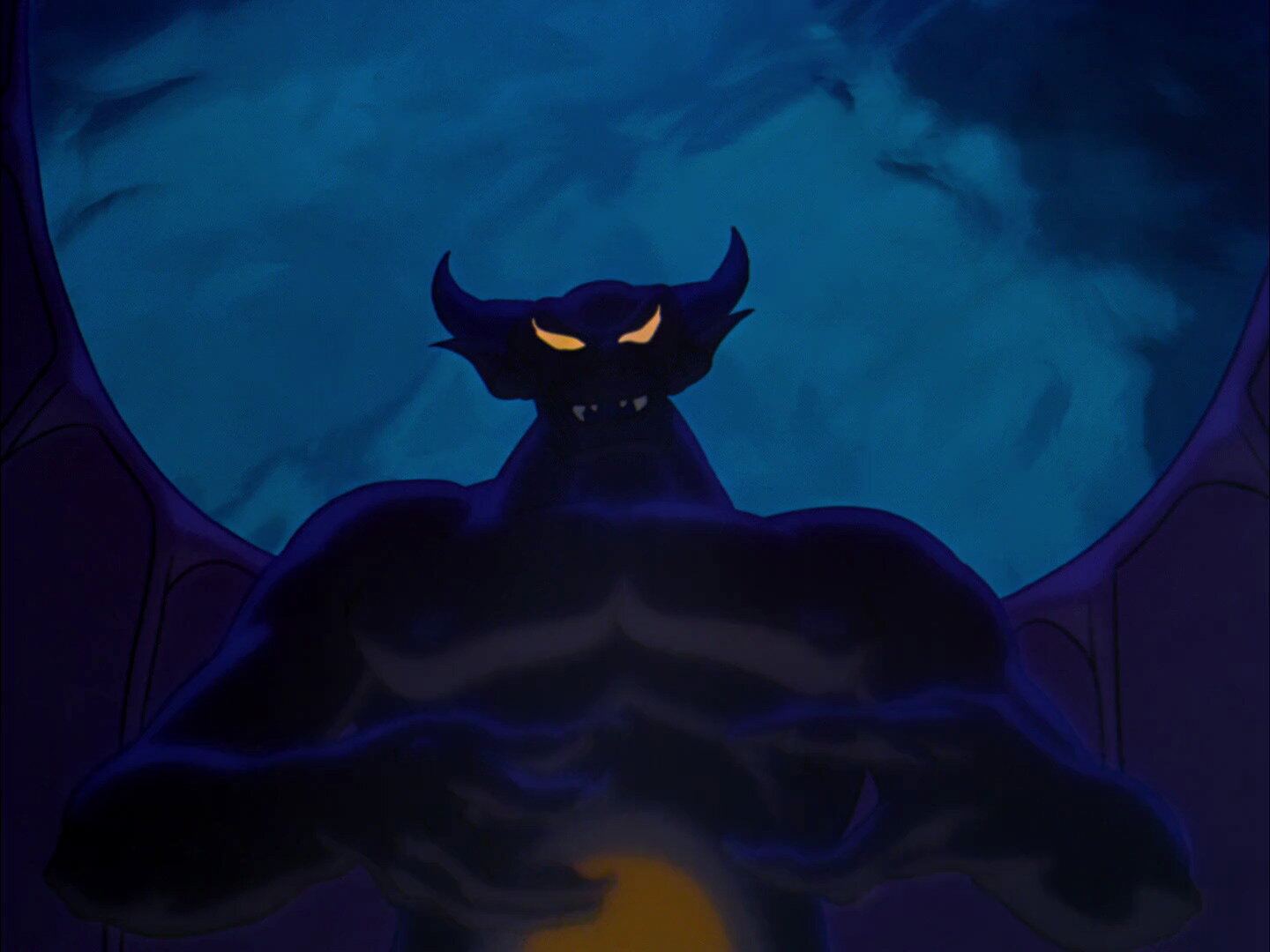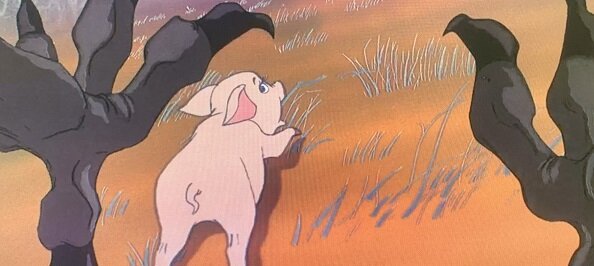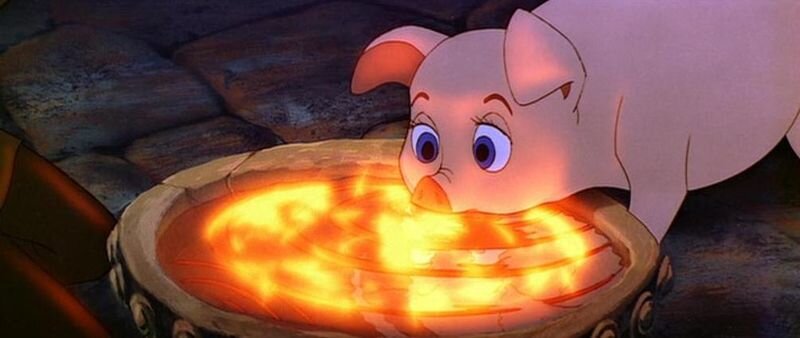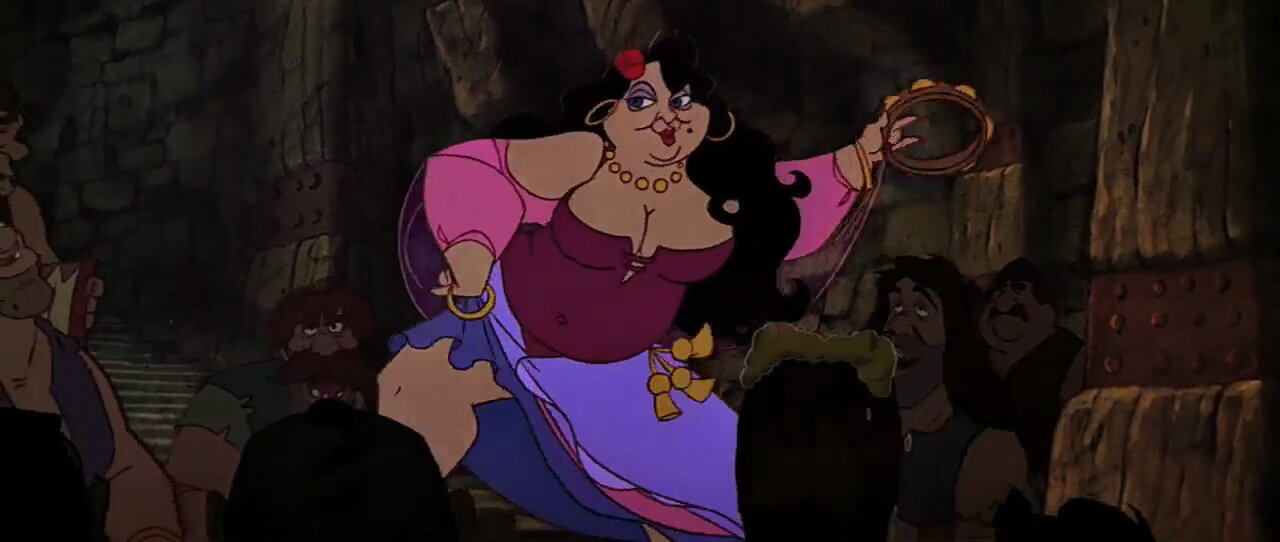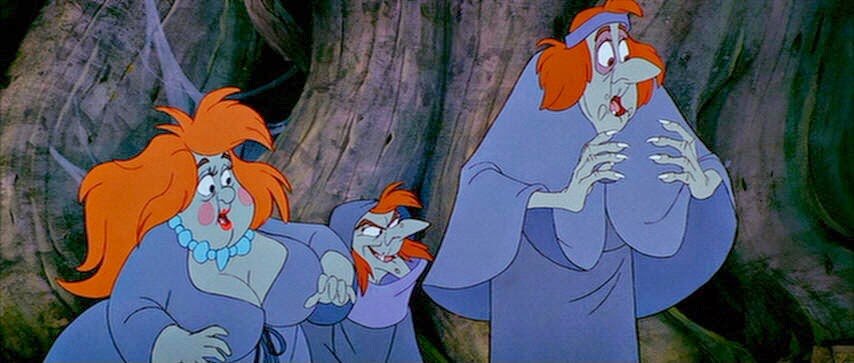Review: The Black Cauldron (DMC #77)
Last night we watched The Black Cauldron, the 77th film in our Disnerd Movie Challenge, and one of the oft-forgotten Disney animated fairytale films. (Does Princess Eilonwy qualify as a true Disney Princess? More on that later…) If you’re already familiar with the film, skip over our synopsis and jump straight to our review.
Synopsis
According to legend, in the mystical land of Prydain, the spirit of an evil king was captured in a giant Black Cauldron. The cauldron became powerful enough to resurrect an army of the dead, so the cauldron was hidden from those who would use its power for evil. Though many have searched for it, none have found it. Meanwhile, on a farm, a young pig keeper named Taran dreams of joining the war against the evil Horned King to prove himself as a hero, despite the warnings of his guardian, Dallben, who senses great danger at hand. While Taran is giving the pampered pig, Hen Wen, a bath, the pig freaks out, and Dallben hurries both of them inside where he reveals that the pig has magic powers that can reveal visions. He tries never to use Hen Wen’s power, but he must know what is troubling her. Hen Wen’s vision shows the Horned King searching for the Black Cauldron—and he knows about Hen Wen. Dallben instructs Taran to go on ahead and take Hen Wen somewhere safe so the Horned King can’t use Hen Wen’s powers to find the cauldron. Meanwhile, in the Horned King’s castle, the king promises a room full of dead soldiers that soon he will make them Cauldron-born, and he’ll be a god. Taran, meanwhile, leads Hen Wen through the woods, but when he gets distracted with imagining himself a hero, Hen Wen wanders off. In trying to find the missing pig, Taran meets Gurgi, a furry creature who’s after Taran’s apple. Taran and Gurgi soon discover Hen Wen being chased by dragons. Though Taran tries to rescue the pig, she is snatched up by one of the dragons and carried off to the Horned King’s castle. Gurgi refuses to go with Taran to the castle, so Taran sneaks into the Horned King’s castle alone. In the castle, Taran watches as the Horned King’s minions, including a goblin named Creeper, escort the prisoner, Hen Wen, to the Horned King. When Hen Wen refuses to obey Creepers orders to use her magic, Taran drops into the room to stop them. The Horned King, recognizing the relationship between the boy and the pig, orders Taran to make Hen Wen use her powers. When Taran refuses, the Horned King orders his minions to kill Hen Wen. Taran finally agrees to help the Horned King to save Hen Wen’s life. Once the vision begins, however, Taran spills the basin of water, shattering the vision before the Horned King can see where the cauldron is. Taran makes a run for it with the pig. Taran manages to help Hen Wen jump from a tower to the castle moat below where she can swim for safety, but Taran is captured by the Horned King’s men and thrown into the dungeon.
In the dungeon, Taran wallows and blames himself for being so careless to lose Hen Wen in the first place. His misery is interrupted when Princess Eilonwy emerges from the dungeon floor with a floating magic bauble. The Horned King captured her, too, thinking her bauble could help him find the Black Cauldron. She leads Taran back through the way she came into tunnels beneath the castle where the two come upon an old burial chamber, probably belonging to the previous king. Taran inspects the old king’s coffin and takes the sword laying on top of it. As Taran and Princess Eilonwy continue on their way, they witness Creeper ushering in a cart load of dead bodies, and they watch as a bard with a magic harp is tied up in a cell. When the guards leave, Taran and Princess Eilonwy begin to untie the bard, but they’re forced to run when they hear guards approaching. Taran drops his sword and becomes separated from the princess while retrieving it. He soon comes face to face with a guard and uses the sword—which turns out to be a magic sword. The princess soon finds him again and Taran, newly overconfident with the sword’s magic, leads a charge through the castle, using the sword’s magic to fell any guards in their way. The bard,
Fflewddur Fflam, flees from a guard dog to join Taran and Eilonwy, and the three manage to escape the castle. Creeper brings the bad news to the Horned King: they have all escaped. The Horned King tells Creeper to send his guards to follow the boy—he’ll lead them right to the pig. Meanwhile, in a forest clearing, the bard serenades Taran and Princess Eilonwy while the princess sews the bard’s pants back together after the guard dog tore them. However, when Taran tries to insist that he was the one responsible for rescuing them from the castle, Princess Eilonwy reminds Taran that if it weren’t for her he would still be trapped in the dungeon. The two continue to argue before stalking off away from each other. A short time later, Taran approaches Princess Eilonwy who’s crying. She tells Taran that they’ll have to work together, and Taran thanks Eilonwy for her help in getting him out of the dungeon. Just as the two make up, they hear Fflewddur cry out for help and rush to his aid to find Gurgi crawling all over the bard. Though Gurgi says he’s Taran’s friend, Taran says Gurgi isn’t his friend since Gurgi abandoned him when he needed him. Princess Eilonwy finds Gurgi cute, however, and when Gurgi mentions he saw the pig’s tracks, they all decide to follow him. They follow Hen Wen’s tracks to a small pond, but when they try to cross the pond via footstones, the pond turns into a whirlpool and sucks them all into a fairy realm beneath the pond.
The fairies find the heroes passed out as the king of the fair folk berates a yellow fairy named Doli for not properly repairing the whirlpool so things like this wouldn’t happen. When the heroes wake, they learn from the fairies that Hen Wen fell into here, too. Hen Wen is reunited with them. The Fairy King reveals that he knows where the cauldron is hidden—in Morva. Taran decides they should get to the cauldron first and destroy it so the Horned King can’t use it. Doli is chosen to escort them to Morva while the others send Hen Wen back home to the farm for safety. In the marshes of Morva, Taran, Eilonwy, Fflewddur, Gurgi, and Doli come upon a witchy hut that appears to be empty, though eyes watch the heroes from every corner. The heroes soon discover the hut is full of frogs who used to be people. The three witches who live there reveal themselves and threaten to turn the heroes into frogs. Taran demands the Black Cauldron from them, and the witches offer a trade: the Black Cauldron for Taran’s magical sword. Taran reluctantly agrees to the exchange, and the witches disappear in a tornado that sucks up their hut with them. Soon after, the Black Cauldron rises from out of the ground. The witches reappear in a cloud and tell the heroes that the Black Cauldron cannot be destroyed—only its evil powers can be stopped, but that would require a living being climbing into the cauldron of their own free will, never to come out again. The heroes, feeling defeated by this news, wallow in their misery. Doli, fed up with this adventure, returns home. Taran blames himself—without his sword, he’s nothing. But Princess Eilonwy believes in him. Taran expresses his gratitude to the others just as the Horned King’s dragons and soldiers appear. Gurgi flees but the others are captured and taken back to the Horned King’s castle—with the cauldron.
Taran, Eilonwy, and Fflewddur are held captive and made to watch as the Horned King uses the Black Cauldron to resurrect his room full of dead soldiers. As the magic begins to raise the dead, Gurgi sneaks through the castle’s sewers. As the Horned King leaves to watch his army of Cauldron-born soldiers march out of his castle toward the war, Gurgi sneaks into the chamber where the others are being held and unties them. Taran is determined to stop the cauldron’s magic and heads toward the cauldron, intending to throw himself in, but Gurgi stops him. Gurgi insists that Taran has friends, but Gurgi has none, so Gurgi throws himself into the cauldron. With Gurgi’s sacrifice, the cauldron’s magic is undone. The Cauldron-born become dead once more, and the cauldron begins to suck its magic back in. Taran tells Eilonwy and Fflewddur to flee, but he goes back to the cauldron to check on Gurgi, holding onto the castle pillars to avoid being sucked into the cauldron. When the Horned King goes after Taran, the king is sucked in by the cauldron’s magic. His flesh is ripped from his body as he’s pulled in and destroyed. The cauldron falls through the floor as the castle crumbles. Taran, Eilonwy, and Fflewddur flee via a small boat and sail away from the castle as it collapses. The heroes make it safely to land and cauldron appears floating on the water. The witches appear in the sky once again, determined to reclaim the cauldron now that Taran no longer has need of it. Fflewddur intervenes, ordering the witches that they must bargain for the cauldron. The witches offer Taran the magic sword, but Taran doesn’t want the sword. All he wants is Gurgi back. After the bard accuses the witches of having no real power, the witches prove the bard wrong by magically delivering Gurgi to the heroes. Though Gurgi appears lifeless at first, the heroes soon celebrate that he’s alive. The four of them walk off together into the sunset, while back on the farm, Dallben looks on at one of Hen Wen’s visions, approving of Taran’s job well done.
Thoughts Before Watching
Megan: I’m weirdly excited for this one. I’ve heard it’s not great, but it’s one of the few Disney animated films I’ve never seen before, and I’m curious to see what everyone means by it not being on par with other Disney animated classics. I’m not going in with high expectations by any means, but it can’t be as bad as some of those live action flicks from the ‘70s…can it?
Kevin: This was one of the few Walt Disney Animation Studios films that my parents didn’t own, and for a while I thought it wasn’t even a Disney movie. I’ve seen this only once before, when I did my solo marathon of the Disney animated films a few years ago. Honestly, I don’t really remember most of it because I found the story to be pretty boring. In a way, I’m going into this blind, so it will be interesting to see where I stand on this afterwards.
Thoughts After Watching
A complicated story made too simple that there’s no weight to anything
Kevin: In keeping with Disney’s model of adapting fairy tales, legends, myths, and folklore for their animated films, The Black Cauldron was loosely based on the first two novels of The Chronicles of Prydain by Lloyd Alexander. The books are a series of five children’s high-fantasy novels. I haven’t read the books myself, but from what I understand they have been well received. The series apparently follows many of the classic hero’s journey tropes and features over thirty characters and multiple story threads. I get the sense that the series is thus similar to other multi-book epic stories such as The Lord of the Rings and A Song of Ice and Fire. The difference between Disney’s adaptation of Alexander’s series and the adaptations of the latter two is that Disney essentially tried to trim a long story into an 80 minute film. Peter Jackson didn’t attempt to cram Tolkien’s trilogy into a single movie (although he did unnecessarily stretch The Hobbit out into a trilogy of its own…). Nor did David Benioff and D.B. Weiss try to tell the story of Westeros in a mini-series (but, then again, I think most fans of Game of Thrones would agree that the last season was… disappointing. Hmm… maybe adapting long book series into condensed film and/or television series isn’t a great idea). Joking aside, while it’s natural for some story elements to be cut when adapting a book to film or T.V., The Black Cauldron seems to have gone a bit too far. The plot feels mostly contrived, with the plot driving the characters rather than the characters driving the plot. It doesn’t help that the confusion starts right when the movie begins. After Megan and I watched this, I had to go back and re-watch the opening narration; it took a second listen for me to better understand it. I was so sure that the nameless king mentioned in the narration would be the Horned King. I mean, that just seemed to make the most sense. Ultimately I was still confused by the narration. Who is this unknown evil king whose spirit eventually contaminated the Black Cauldron? Why was he so evil? Is there a connection at all between the Cauldron and the Horned King? The movie appears to imply there is one, but doesn’t go into detail. Instead, the Horned King just kind of comes out of nowhere, and the story behind the Black Cauldron may as well not exist since it doesn’t affect the story either way.
Kevin: There are also some noticeable edits in the film thanks to then-Disney chairman Jeffrey Katzenberg. Many of the edits came about as a result of the film’s poor test screening with children, particularly the “Cauldron-born” sequence. The sequence was reportedly so terrifying to children that Katzenberg ordered the film to be edited. The problem, as anyone who understands animation knows, is that animation can’t be edited the same way a live-action film or T.V. show can. Cuts in animation are usually done during storyboarding using animatics (storyboards shot in sequential order and set to audio). Animatics are an important component of animation editing because of how much time animation takes to finish. It’s a lot easier to remove storyboards than to cut entire animation that’s already been synced to music and sounds. Unfortunately, Katzenberg tried the second option. Though eventually convinced to stop, he still requested some bits of the film be modified and changed. In the end, twelve minutes were cut from the film, and the crew had to rewrite and reanimate certain scenes to keep the flow going. Some of this included removing character interactions (a bit more on that down below), but the most infamous removal was during the “Cauldron-born” scene, where one of the Horned King’s henchmen is overtaken by the skeletons. The original draft showed the henchman having his skin and muscles melted from him as he is dissolved by the green mist. Given the context, I can understand why this was removed. I’m gonna leave the shots out here, but if you’re curious you can find the deleted scenes/shots with a quick Google search. However, it created a very obvious jump in the soundtrack. Another edit involved the Cauldron-born escaping into Prydain and attacking the land, but this sequence was cut out for being deemed too graphic as well. The film spent a good portion of its plot talking about how dangerous this army would be, and they’re destroyed in a matter of minutes. This cheapens the threat the Horned King poses to the characters since the finished film looks like his army is stopped before they’ve even left the castle. Talk about wasted efforts! It leaves the film feeling a bit hollow since we never really see the Horned King’s true terror. Some of these edits, however well intentioned they may have been, don’t help the movie at all. It was probably a difficult feat to adapt a series to begin with, and Disney probably wasn’t the best studio to try to adapt it just given their family-friendly reputation.
A film that strays from the Disney brand
Megan: Now that I’ve seen this movie, I can see why people often don’t consider The Black Cauldron to be a “true” Disney animated classic. Compared to Disney’s previous medieval animated stories like Cinderella, Snow White, and Sleeping Beauty, The Black Cauldron strays just a little too far from Disney’s family-friendly “Disney Princess” brand image, which is possibly why the film was such a major flop at the box office. It’s not just that The Black Cauldron is based on a novel rather than a classic fairytale, although that does contribute to the non-Disney “voice” of the film. No, there are other elements of this film that just don’t feel like they belong in a Disney animated feature. 20th Century Fox, perhaps, or maybe Universal, but not Disney. The first instance that stuck out as off-brand for Disney was the threat of beheading the pig, Hen Wen. Disney villains can be dastardly, yes, and there are some pretty nasty fates that befall those villains, but putting the hero’s adorable pig in danger of being brutally beheaded by a giant axe? Never mind that the pig is safe because Taran gives in to the Horned King’s demands, that is still a frightening image for a Disney film. Compare that to when the chef tries to cook Sebastian in The Little Mermaid—similar threat of imminent danger from an axe-like weapon, yet one is handled comedically with a somewhat inept villain in a bright color scheme (The Little Mermaid) while the other maintains a dark and foreboding tone and color scheme with a very real threat (The Black Cauldron). I don’t remember ever truly being afraid for Sebastian when I watched The Little Mermaid for the first time (or any time thereafter), but there was a moment there when watching The Black Cauldron that I was thinking “This is a Disney movie…they can’t kill the cute pig…can they?”
Megan: Another off-brand element for Disney? The Horned King himself. It’s not his skeleton-like appearance, though (he’d fit right in with Chernabog and his ghostly skeletons in Fantasia). It has more to do with his villainous plot and how he collects dead bodies to store in his castle until he can use the black cauldron to reincarnate them. Sure, the bodies are more skeletons than bodies by the time they make it to him, but it’s still a pretty dark turn for a Disney villain. The Horned King’s end is even more disturbing. He isn’t just sucked into the Black Cauldron. His flesh is quite literally ripped from his bones! You can even see the muscles being torn from his skeleton! Gross! It reminded me of the villain, Rasputin, from Anastasia (which, ironically, is a 20th Century Fox animated film that is often confused for a Disney film). Rasputin is quite literally a rotting corpse of a man because he sold his soul and cannot truly die, and yet his ultimate end (a disintegrating skeleton) is less disturbing than the Horned King’s (flesh being ripped from a skeleton).
Kevin: The Horned King is definitely disturbing for a Disney film. However, that’s all in his design and not so much in his actions. He really doesn’t seem to be much of a threat when looking at the finished film. In terms of his design choices, desires, and way of introduction, he seems to be a bit of a callback to earlier Disney villains like the Evil Queen and Maleficent in terms of “big scary villain,” but he very much lacks their charisma and true level of power. While we didn’t need backstories for the Evil Queen or Maleficent, I was a bit confused about where the Horned King fit into all of this. As mentioned before, I originally thought he had some connection to the ancient king mentioned in the opening narration, or perhaps was that very king. Instead, he’s just the current evildoer who is after the Black Cauldron so he can do evil things. Meh, that’s not all that intriguing. He’s also less interesting because he does almost nothing throughout the movie except give orders to his henchmen or Cauldron-born army (which, as stated earlier, is defeated within a few short minutes of being created). True, he does order the execution of Hen Wen, and that is a horrific scene that thankfully doesn’t play out, but it’s probably the only truly terrifying scene the Horned King has. Otherwise, he just sits around and looks scary. He even has a rather cheap death scene, not in terms of the graphic nature (because it is graphic) but because of how it happens: he grabs Taran’s face for a moment, but Taran merely kicks the Horned King, who is soon sucked into the Cauldron and destroyed. Again, not very entertaining, and just another way his character is cheapened.
The first Disney animated film to use CGI
Kevin: There’s a bit of a mixed bag as to whether the animation here is good or bad. Personally, I think the animation in this movie was pretty darn good. Obviously it’s not up to the films we’ll see pretty soon, but this is some quality stuff. The Black Cauldron uses the Xerox method from earlier films, but by this point the studio looks like they’ve figured out how to use it effectively. The animation is certainly a lot smoother than it was in the last several animated films. I’ll again say that one of the joys of watching Disney’s animated movies is seeing the progress of the animation. Because they can take years to make, many animated movies are worked on at the same time, so it’s not surprising that the styles continue to build on what came before them. The Black Cauldron is noted for being the first Disney animated film to incorporate CGI, and I gotta say that it looks wonderful. There’s one particular shot that stood out to me, and it’s when the gwythaints are chasing Hen Wen. See the picture above for the shot I’m referring to, which really doesn’t do it justice. You’d be better off watching it yourself if you haven’t already. The scene looks so smooth and crisp. CGI was also used to get the special effects of the titular Black Cauldron. I don’t think the effects would have worked as well had they been hand-drawn. Sure, at times the smoothness of the CGI can look out of place with hand-drawn animation if it looks too jagged, but I honestly found it to be interesting. CGI would go on to be used in many of the Disney Renaissance films and beyond, and before too long it would become the staple of the next generation of 3D animation.
Does Princess Eilonwy count as a true Disney Princess?
Megan: Kevin brought this one up while we were watching: if we were to use the list of Disney Princess traits enumerated by the Disney Princesses themselves in a scene from Ralph Breaks the Internet, would Princess Eilonwy qualify?
Does she have magic hair? No.
Does she have magic hands? No.
Do animals talk to her? That depends. Is Gurgi an animal?
Was she poisoned? No.
Cursed? No.
Kidnapped or enslaved? Yes—the Horned King captured her.
Did she make a deal with a sea witch? No.
Has she shared true love’s kiss? No—that kiss between her and Taran at the end of the film is definitely NOT true love’s kiss.
Does she have daddy issues? Unclear, since we never meet her father or learn of him.
Does she have a mom? Unclear, since we also don’t meet her or learn of her.
Do people assume all her problems were solved because a big strong man showed up? Yeah, just a bit. Taran totally assumes that he’s the one to credit for helping Eilonwy escape because he found the magic sword and used it, despite the fact that without Eilonwy’s help in breaking him out of his dungeon cell he never would have found the sword or escaped in the first place. So yes, she gets a point here.
Does she sing about her dreams, perhaps while staring at important water to reflect? Nope and nope.
So, by this measure, Princess Eilonwy gets two solid points for being kidnapped and for a male character thinking he solved all her problems, and half credit for the possible talking to animals and the absent parents. I guess that makes her a Disney Princess. But is she really a princess to begin with? Did anyone else catch that the Horned King insults Eilonwy by calling her a “scullery maid,” but insults the male characters by calling them what they actually are—a pig keeper and a minstrel? Was Eilonwy only pretending to be a princess? (This video I came across does a good job of breaking down that puzzle a bit further.) Still, whether Eilonwy is merely a scullery maid or a real princess, I can see why she hasn’t stood alongside the other Disney Princesses in Disney’s catalog. Compared to the other princesses, she has very little control over her own story. The only times we see her impact the story are when she breaks into Taran’s dungeon cell, and when she stands up to Taran after he tries to take all the credit for their escape in the following exchange:
TARAN: Well, I got us out of the castle, didn’t I?
PRINCESS EILONWY: You? I’d say it was the sword’s magic.
TARAN: But it takes a great warrior to handle a sword like this.
PRINCESS EILONWY: But still. It is a magic sword.
TARAN: Hah! What does a girl know about swords anyway?
PRINCESS EILONWY: Girl? Girl? If it weren’t for this girl, you would still be in the Horned King’s dungeon.
FFLEWDDUR: Here now. Princess Eilonwy, Taran…
PRINCESS EILONWY: At least I don’t keep talking about it forever! Oh, you’re so…so boring!
FFLEWDDUR: Princess Eilonwy.
PRINCESS EILONWY: How dare you take his side!
FFLEWDDUR: I really didn’t mean to interfere…
TARAN: Silly girl! Even if she is a princess!
Megan: Even though I love that Eilonwy is standing up for herself and claiming her own credit where credit is due, it sucks that Fflewddur appears to side with Taran by admonishing Eilonwy more than Taran, and that Taran reduces her to a “silly girl” at the end. Honestly, it kind of sucks to be Eilonwy. Throughout the rest of the film, she is merely along for the ride. Even though she has a magic bauble (which mysteriously disappears after the characters escape the Horned King’s castle), she doesn’t really have a chance to add anything valuable to the team’s adventure—and that’s by design. Though it may not have been consciously intentional, this film is the story of a boy written largely by men, with very little room for a female character to shine. There is only one woman with a writing credit on the film (Rosemary Anne Sisson), and that credit is only for “additional dialogue.” While it’s hard to say for certain which additional dialogue Rosemary wrote, I suspect it may have been Princess Eilonwy’s dialogue in the above exchange, since it’s some of the only dialogue in the film that allows Princess Eilonwy to show her own power in a film where she’s largely outnumbered by male characters. The only other female characters in the film are the pig, Hen Wen, who never speaks; the witches, who never speak directly to Eilonwy; and one little girl fairy, who also never speaks directly to Eilonwy. Thus, this film fails the Bechdel test.
Kevin: By the way, the above conversation is apparently not the entire original dialogue. Does that accusation from Eilonwy to Fflewddur about taking sides seem just a tad out of left field? From what I could research, pieces of Taran and Eilonwy’s argument were cut, a result of the aforementioned edits Katzenberg made to the film. I couldn’t find drafts of the actual script, but the implication is that Taran and Eilonwy continued to banter back and forth. Fflewddur was supposed to have interfered even more, with him making a comment that leads to Eilonwy calling him out. I’m not sure what he says, exactly, but it looks as if there was meant to be more to this exchange. Indeed, supposedly a lot of Fflewddur’s lines were removed from the film, leaving him less of the warm-hearted mediator between Taran and Eilonwy and more of the buffoonish sidekick. I could understand the desire to cut scenes out if they were too terrifying, but the decision to cut what sounds like important bits of dialogue doesn’t help characters like Eilonwy and Fflewddur.
The sexism is painful
Megan: I recognize that this film was made in 1985 and I’m watching it for the first time in 2021, but that doesn’t excuse the painful-to-watch sexism that appears in this movie. The depictions of female characters range from just okay to terribly insulting. Let’s start with the “just okay” category. We’ve already talked a bit about Princess Eilonwy and how she gets pushed to a backseat role on Taran’s adventure, but she’s not the only one shoved into a damsel-in-distress/object-of-desire trope. Yes, even the pig, Hen Wen, who never speaks, finds herself in the damsel-in-distress/object-of-desire box. Sure, Eilonwy is a (albeit, reluctant) romantic “object of desire” for Taran whereas Hen Wen is more like a literal object that both hero and villain are seeking, but the point still stands that both female characters are desired and sought after by male characters. And they both find themselves in some level of distress which requires rescue by a male character—despite (or perhaps because of) their magical object or powers. In a similar vein, neither female character has much control over their fate in the adventure. Their actions have little impact on the story, except in service to Taran’s story. That’s not a whole lot for young girls watching this film to aspire to.
Megan: On the opposite end of the spectrum we get the terribly insulting sexist representations. The more glaring of these is the sexist and racist depiction of a gypsy woman who’s dancing for the Horned King’s men. First of all, there is NO REASON for her to be in the film! NONE! Her appearance has no bearing whatsoever on the story, so why include her in the first place? The short answer: sexism, with a hint of racism. It wasn’t enough to show that the villains were villains in their appearance—apparently they also needed to be shown gawking at a busty gypsy woman. And of course, the gypsy woman had to look “exotic” and somewhat inhuman. Take a look at the way her face is drawn compared to Eilonwy’s face. They both might be animated characters, but the gypsy woman’s features are exaggerated far more than Eilonwy’s, and our attention is immediately drawn to the gypsy woman’s cleavage. In appearance, the gypsy woman has more similarities with the busty witch than Eilonwy. While this could be an intentional art style to show that the gypsy woman is one of the villains and not one of the heroes, I have to wonder, is she truly a villain? Or is she as much a prisoner as Taran and Eilonwy, forced to perform for gross men or risk being killed?
The other problematic depiction: the witches. This is unfortunately a common trope. Women are often thrown into princess/witch categories much like the Madonna/whore complex, and outside of the Harry Potter books and films, the stereotypical witch is an ugly old hag. The witches in this film are no different. Two of the three have the stereotypical warts, pointy noses, and claw-like fingers. The third you could say is perhaps the most “attractive” of the three, though even she has her own ugliness in her over-application of makeup. This third witch is perhaps the most problematic of the three. The first offense is her immediate infatuation with the bard. Much like the more voluptuous squirrel in The Sword in the Stone becoming overly infatuated with Merlin (more on that in our previous review), this witch doesn’t know when to back off of Fflewddur. She’s only just met him and immediately wants to arrange a marriage. True, we don’t often see the woman being the one who’s too overly forward—usually we see male characters doing that. However, it’s unflattering when the male character does it, and it’s unflattering when the female character does it—especially since having the female character be overly infatuated is usually a way of poking fun at that female character. This witch is definitely the comedic relief/butt-of-the-joke character, as evidenced by the unnecessary antics between her and Fflewddur when Fflewddur, having been turned into a frog, gets stuck between the witch’s breasts (something else that seems very off-brand for Disney). I believe the filmmakers intended the moment to be funny, but I found myself rolling my eyes at yet another sexist joke. Also, talk about a film that furthers unattainable beauty ideals. Princess Eilonwy, a young girl, is thin and attractive, and at least somewhat normally proportioned for an animated character. However, the gypsy and at least one of the witches are made to look unflattering for having a fuller figure, and in the case of the witch, she’s meant to be made fun of by the audience for having a larger figure. Of course, young girls watching this film are meant to identify with Princess Eilonwy, but the subtle message is still there: beauty=good, ugliness and fatness=bad or evil.
Overall, not nearly as bad or boring as remembered
Kevin: I’d like to close with at least some bit of positivity, and that’s to say that this film was slightly more enjoyable than when I last watched it. Excluding the weird jump cuts, I loved many of the animated sequences and there are some particularly funny moments with Gurgi and Fflewddur. Taran and Eilonwy aren’t the most interesting protagonists, but their banter does bring some humanity to them. I still don’t think the Horned King is all that impressive either (maybe if I saw this movie as a child he would have been more terrifying), though I think he marks Disney’s slow return to actually threatening villains. I’m definitely not saying that The Black Cauldron is good. Disney was apparently ashamed of this movie for a long time, but it’s not bad because it’s dark. It’s bad because of its confusing plot and lack of good characters, traits that seemed to plague many of Disney’s movies from the ‘70s and ‘80s.


